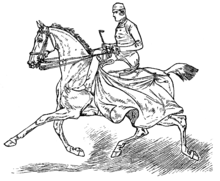Desensitization (psychology)
| Desensitization (psychology) | |
|---|---|
| Intervention | |
| MeSH | D003887 |
In psychology, desensitization is defined as the diminished emotional responsiveness to a negative or aversive stimulus after repeated exposure to it. It also occurs when an emotional response is repeatedly evoked in situations in which the action tendency that is associated with the emotion proves irrelevant or unnecessary. Desensitization is a process primarily used to assist individuals unlearn phobias and anxieties and was developed by psychologist Mary Cover Jones.[1][2] Joseph Wolpe (1958) developed a method of a hierarchal list of anxiety evoking stimuli in order of intensity, which allows individuals to undergo adaption.[3] Although medication is available for individuals suffering from anxiety, fear or phobias, empirical evidence supports desensitization with high rates of cure, particularly in clients suffering from depression or schizophrenia.[4]
Steps to desensitization
The hierarchal list is constructed between client and therapist in rank ordered series of steps from the least disturbing to the most disturbing fears or phobias. Secondly the client is taught techniques that produce deep relaxation. It is impossible to feel both anxiety and relaxation at the same time, so easing the client into deep relaxation helps inhibit any feelings of anxiety. Systematic desensitization (a guided reduction in fear, anxiety or aversion) can then be achieved by gradually approaching the feared stimulus while maintaining relaxation. Desensitization works best when individuals are directly exposed to the stimuli and situations they fear so anxiety–evoking stimuli are paired with inhibitory responses. This is either carried out by performing in real life situations (known as vivo desensitization), or if it is not practical to directly act out the steps of hierarchy, clients can observe models performing the feared behaviour (known as vicarious desensitization). Clients slowly move up the hierarchy repeating performances if necessary, until the last item on the list is performed without fear or anxiety.[5]
Effects on animals

Animals can also be desensitized to their rational or irrational fears. A race horse who fears the starting gate can be desensitized to the fearful elements (the creak of the gate, the starting bell, the enclosed space) one at a time, in small doses or at a distance. Clay et al. (2009) conducted an experiment whereby he allocated rhesus macaques to either a desensitization group or a control group, finding that those in the desensitization group showed a significant reduction in both the rate and duration of fearful behavior. This supports the use of PRT training. Desensitization is commonly used with simple phobias like insect phobia.[6][7]
Effects on violence
Desensitization also refers to the potential for reduced responsiveness to actual violence caused by exposure to violence in the media, although this topic is debated in the science.[8] Desensitization may arise from different sources of media including TV, video games and movies. Some scholars suggest that violence may prime thoughts of hostility with the possibility of affecting the way we perceive others and interpret their actions.[9] It is hypothesized that initial exposure to violence in the media may produce a number of aversive responses such as increased heart rate, fear, discomfort, perspiration and disgust. However, prolonged and repeated exposure to violence in the media may reduce or habituate the initial psychological impact until violent images do not elicit these negative responses. Eventually the observer may become emotionally and cognitively desensitized to media violence. In one experiment participants who played violent video games showed lower heart rate and galvanic skin response readings which the authors interpreted as displaying a physiological desensitization to violence.[10] However, other studies have failed to replicate this finding.[11][12] Some scholars have questioned whether becoming desensitized to media violence specifically transfers to becoming desensitized to real-life violence[13]
See also
- Systematic desensitization
- Sensitization
- Flooding (psychology)
- Extinction (psychology)
- Habituation
- Conditioning
References
- ↑ Stolerman, Ian (2010). Encyclopedia of Psychopharmacology. Berlin Heidelberg: Springer.
- ↑ T.L. Brink (2008) Psychology: A Student Friendly Approach. "Unit 6: Learning." pp. 101
- ↑ Coon (2008). Psychology: A Journey. USA: Thomson Wadsworth Corporation.
- ↑ Nemeroff, C.B. (2001). The Corsini Encyclopedia of Psychology and Behavioral Science. Canada: John Wiley & Sons.
- ↑ Coon (2008). Psychology: A Journey. USA: Thomson Wadsworth Corporation.
- ↑ Chamove, A.S. (2005). Spider Phobic Therapy Toy. The Behavior Analyst Today, 6(2), 109–25 BAO
- ↑ CARNAGEY, N; ANDERSON, C; BUSHMAN, B (1 May 2007). "The effect of video game violence on physiological desensitization to real-life violence☆". Journal of Experimental Social Psychology 43 (3): 489–496. doi:10.1016/j.jesp.2006.05.003.
- ↑ Freedman, J.L. (2003). Media Violence and its effect on aggression: assessing the scientific evidence. Canada: University of Toronto Press Incorporated.
- ↑ Paludi, M.A. (2011). The Psychology of Teen Violence and Victimization. USA: ABC-CLIO, LLC.
- ↑ Gentile, D.A. (2003). Media Violence and children: a complete guide for parents and professionals. U.S.A.: Greenwood Publishing Group Inc.
- ↑ "Failure to Demonstrate That Playing Violent Video Games Diminishes Prosocial Behavior."
- ↑ "Comfortably numb or just yet another movie? Media violence exposure does not reduce viewer empathy for victims of real violence among primarily Hispanic viewers."
- ↑ "How gamers manage aggression: Situating skills in collaborativecomputer games"
| ||||||||||||||||||||||||||||||||||||||||||||||||||||||||||||||||
Definition of agoraphobia: http://en.wikipedia.org/wiki/Agoraphobia